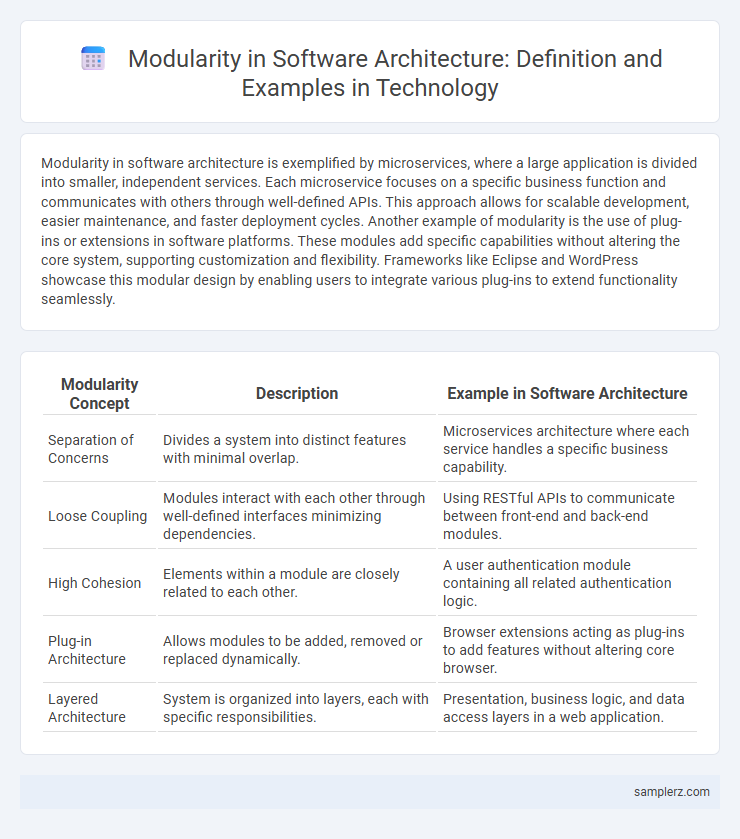Modularity in software architecture is exemplified by microservices, where a large application is divided into smaller, independent services. Each microservice focuses on a specific business function and communicates with others through well-defined APIs. This approach allows for scalable development, easier maintenance, and faster deployment cycles. Another example of modularity is the use of plug-ins or extensions in software platforms. These modules add specific capabilities without altering the core system, supporting customization and flexibility. Frameworks like Eclipse and WordPress showcase this modular design by enabling users to integrate various plug-ins to extend functionality seamlessly.
Table of Comparison
| Modularity Concept | Description | Example in Software Architecture |
|---|---|---|
| Separation of Concerns | Divides a system into distinct features with minimal overlap. | Microservices architecture where each service handles a specific business capability. |
| Loose Coupling | Modules interact with each other through well-defined interfaces minimizing dependencies. | Using RESTful APIs to communicate between front-end and back-end modules. |
| High Cohesion | Elements within a module are closely related to each other. | A user authentication module containing all related authentication logic. |
| Plug-in Architecture | Allows modules to be added, removed or replaced dynamically. | Browser extensions acting as plug-ins to add features without altering core browser. |
| Layered Architecture | System is organized into layers, each with specific responsibilities. | Presentation, business logic, and data access layers in a web application. |
Introduction to Modularity in Software Architecture
Modularity in software architecture enables the division of a system into distinct, interchangeable components or modules, each responsible for a specific functionality. This approach enhances maintainability, scalability, and reusability by allowing developers to update or replace individual modules without affecting the entire system. Popular examples include microservices architecture and plugin-based systems, which demonstrate how modularity facilitates independent development and deployment within complex software environments.
Key Principles of Modular Software Design
Modular software design emphasizes separation of concerns, allowing independent development, testing, and maintenance of software components. Key principles include high cohesion within modules, low coupling between them, and clear interface definitions to facilitate seamless integration. This approach enhances scalability, flexibility, and reusability, optimizing system complexity and accelerating development cycles.
Benefits of Modularity in Modern Applications
Modularity in software architecture enables developers to build applications with independent, interchangeable components that improve maintainability and scalability. This approach reduces complexity, allowing teams to isolate and fix issues more efficiently while facilitating seamless integration of new features. Enhanced modularity also promotes reusability of code, accelerating development cycles and optimizing resource management in modern applications.
Microservices as a Modularity Example
Microservices exemplify modularity in software architecture by decomposing applications into independent, self-contained services that communicate via APIs. This modular approach enhances scalability, maintainability, and rapid deployment, enabling teams to develop, test, and deploy components autonomously. Popular platforms like Netflix and Amazon employ microservices to achieve fault isolation, technology diversity, and continuous delivery.
Plugin-based Architectures Explained
Plugin-based architectures exemplify modularity by allowing software systems to extend functionality through independent, interchangeable modules known as plugins. Each plugin operates as a self-contained unit that can be added, removed, or updated without impacting the core system, enhancing scalability and maintainability. This modular approach supports dynamic feature integration and customization, optimizing development workflows in complex software ecosystems.
Service-Oriented Architecture (SOA) Modules
Service-Oriented Architecture (SOA) exemplifies modularity in software architecture by dividing applications into distinct, reusable service modules that communicate via standardized protocols. Each SOA module encapsulates specific business functions, promoting interoperability and scalability across diverse platforms. This modular approach reduces system complexity, accelerates development cycles, and enhances maintenance by enabling independent updates to individual services without impacting the entire system.
Modular Monoliths and Their Structure
Modular monoliths organize software into distinct, self-contained modules within a single deployable unit, enabling better code maintainability and scalability. Each module encapsulates specific functionalities with well-defined interfaces, promoting separation of concerns and reducing interdependencies. This structure balances the simplicity of monolithic deployment with the flexibility of modular design, improving development efficiency and system robustness.
Real-world Modular Frameworks: Case Studies
Microservices architecture exemplifies software modularity by decomposing applications into loosely coupled, independently deployable services, enabling scalability and maintainability. The Spring Boot framework supports modular development through its extensive ecosystem of reusable components and microservices integration. Netflix's OpenFeign showcases modularity by providing declarative web service clients that simplify inter-service communication in cloud-based applications.
Challenges in Implementing Modularity
Challenges in implementing modularity in software architecture include managing inter-module dependencies that can lead to tight coupling and reduced flexibility. Ensuring consistent interfaces across modules demands rigorous design and testing to maintain cohesion and facilitate integration. Scalability issues arise when individual modules evolve asynchronously, complicating version control and system maintenance.
Future Trends in Modular Software Architecture
Future trends in modular software architecture emphasize the integration of microservices and containerization technologies, enabling scalable and maintainable systems. Advances in AI-driven code generation and automated module testing accelerate development cycles and improve component interoperability. Edge computing and serverless architectures further enhance modularity by distributing workloads across diverse environments, optimizing performance and resource utilization.

example of modularity in software architecture Infographic
 samplerz.com
samplerz.com